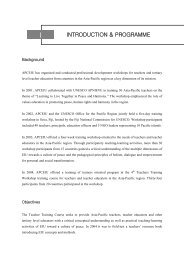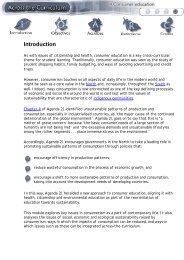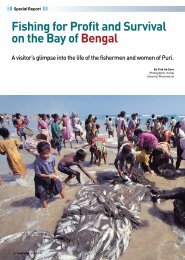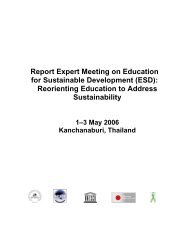Module 11 | Indigenous knowledge and sustainability - APCEIU
Module 11 | Indigenous knowledge and sustainability - APCEIU
Module 11 | Indigenous knowledge and sustainability - APCEIU
Create successful ePaper yourself
Turn your PDF publications into a flip-book with our unique Google optimized e-Paper software.
Natural Remedies <strong>and</strong> Medicines<br />
In many parts of the world, indigenous<br />
societies classify soils, climate, plant <strong>and</strong><br />
animal species <strong>and</strong> recognise their special<br />
characteristics. <strong>Indigenous</strong> people have<br />
words for plants <strong>and</strong> insects that have not<br />
yet been identified by the world's<br />
botanists <strong>and</strong> entomologists. The Hanunoo<br />
people of the Philippines, for example,<br />
distinguish 1600 plant species in their<br />
forest, 400 more than scientists working<br />
in the same area. Of the estimated<br />
250,000 to 500,000 plant species in the<br />
world, more than 85% are in environments<br />
that are the traditional homes of<br />
indigenous people. Nearly 75% of 121 plantderived<br />
prescription drugs used worldwide<br />
were discovered following leads from<br />
indigenous medicine. Globally, indigenous<br />
peoples use 3000 different species of<br />
plant to control fertility alone. The<br />
Kallaywayas, w<strong>and</strong>ering healers of Bolivia,<br />
make use of 600 medicinal herbs;<br />
traditional healers in Southeast Asia may<br />
employ as many as 6500 plants for drugs.<br />
Almost all trees <strong>and</strong> many plants have a<br />
place in medicinal lore.<br />
Some scientists now believe that<br />
indigenous <strong>knowledge</strong> may help them to<br />
discover important new cures for diseases<br />
such as AIDS <strong>and</strong> cancer. Many developed<br />
countries realise the potential for<br />
indigenous medicine. It is locally available,<br />
culturally acceptable, <strong>and</strong> cheaper than<br />
imported drugs.<br />
Case Study: Medicinal Plants in<br />
India<br />
<strong>Indigenous</strong> people work on body <strong>and</strong><br />
mind together to help cure illness.<br />
Medicinal plants are used to treat the<br />
spiritual origins of disease as well as<br />
the physical symptoms. The vast<br />
<strong>knowledge</strong> of such plants is now<br />
beginning to be ac<strong>knowledge</strong>d by the<br />
rest of the world. So is the role played<br />
by indigenous people as custodians of<br />
the world's genetic heritage.<br />
A botanical survey of India revealed<br />
that tribal peoples of the north-east<br />
use plant drugs to cure fevers,<br />
bronchitis, blood <strong>and</strong> skin diseases, eye<br />
infections, lung <strong>and</strong> spleen ulcers,<br />
diabetes, <strong>and</strong> high blood pressure.<br />
Knowledge of their use is passed on by<br />
the 'vaiyas', Indian herbal medicine<br />
doctors. In a single area of 277 sq. km<br />
(107 sq. miles) 210 types of medicinal<br />
plants have been found.<br />
The Kameng <strong>and</strong> Lohit peoples in<br />
Arunachal Pradesh crush a bulk of<br />
Fritillaria cirrhosa to a paste to relieve<br />
muscle pains. Research has now<br />
confirmed the presence of a chemical<br />
similar to cocaine in a related Fritillaria<br />
plant that brings relief to muscular<br />
pain.<br />
Growing evidence of plant-based<br />
contraception is available among many<br />
tribal peoples. Worldwide, over 3000<br />
plants are employed for contraceptive<br />
use. In the Karjat tribal area of<br />
Maharashtra, near the west coast of<br />
India, a native herb taken twice a year<br />
is said to be effective.<br />
Source: Burger, J. (1990) The Gaia<br />
Atlas of First Peoples: A Future for the<br />
<strong>Indigenous</strong> World, Penguin Books,<br />
Ringwood, pp. 32, 38.<br />
The Karjat study concludes that<br />
traditional health practices can provide<br />
up to half of local primary health needs.<br />
Enlightened health-care workers are<br />
beginning to re-introduce traditional<br />
plant remedies where allopathic drugs<br />
have become common-place. Properly<br />
studied <strong>and</strong> recorded, this traditional<br />
<strong>knowledge</strong> could revolutionise the world<br />
of medicine.








